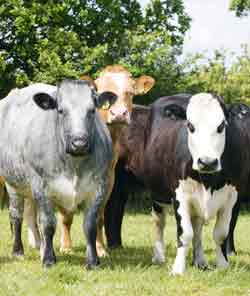Culling barren cows cuts costs

Buying an animal on looks without making appropriate management checks has cost a Norfolk beef producer money and time, but has also spurred major changes. Sarah Trickett reports
Temptation at sales can be hard when a prize-winning, good-looking and well costed bull is flashed before buyers eyes. But for beef producer Roger Moore, luring to the appeal has lost him money by extending calving interval and feeding and housing unknowingly barren cows.
And with only about 65% of cows getting in calf, and a calving period which unintentionally has extended to all year round, it was the financial implications that’s led Mr Moore to get to the source of the problem.
“It all started four years ago when we bought in a bull from Carlisle. We were putting it to the cow and were hoping nature would take its course, but when cows weren’t getting in calf, we decided to get it tested.”
Calling in the vets, results from a semen sample showed the Blonde bull to be totally infertile and on the advice of Norfolk Farm Vets’, Molly Mckay, they are now semen testing all new bulls coming in and pregnancy diagnosing all cows.
“We wanted to know what was going on and by semen testing bulls and PD’ing all cows going to the bull we are no longer working in the dark, meaning we have no hidden surprises,” says Mr Moore.
At a cost of £105 for semen testing bought in bulls and at £2 for every animal PD’d, the investment is a lot cheaper than barren cows, according to Mr Moore.
“Pregnancy diagnosing and semen testing bulls has not only saved money, but it has allowed investment into replacement stock. If cows are not in calf after being with the bulls for a 12 week period, then they are culled.”
And the sums certainly seem to add up. In March this year 55 animals were PD’d at a cost of £110. Those not in-calf were culled and came to an average of £900 an animal. With five cows being culled this raised about £4500.
Mr Moore reckons by not having to feed these animals over the summer and next winter at a cost of about £1.50 a day, the cost of a barren cow would be about £540 a year, this combined with the costs of having no calved produced which would be about £700 store price, equating to about £1240 for every cow not in calf.
With the costs of not getting a cow in calf totalling about £1240 and with Mr Moore having five barren cows this year would have costs him more than £6200.
“By selling these animals means we have removed the costs and gained revenue by selling them. This is irrespective of what the market is doing. If prices aren’t good then it doesn’t stop us because it usually means the price of replacements to buy in will be low, so its swings and roundabout. Something that is not producing is not worth keeping,” he says.
In fact Mr Moore is saving more than £10,000 when combining the total saved and the total made from selling barren cows. “This extra money allows us to buy better quality replacement stock and will hopefully help us tighten the calving pattern.”
And having a tighter calving pattern is essential for Mr Moore, since he is running his 80 cow herd single handily. “Having set periods for calving is essential as I run a shoot, contract at harvesting and also don’t want to be calving over Christmas, so need a tight calving period to fit in with all the other jobs.”
Mr Moore plans to run two groups of cows with the hope to have all calves born within a 10 week period in each group.
Since this scare, Mr Moore has also joined the Premium Cattle Health Scheme, which means all incoming stock is isolated and tested to determine their disease status. “We realised it was too risky and could cost more money in the long run if we were to introduce a disease into the herd. Eventually we are hoping to have a closed herd, so breeding good quality replacement stock will be essential,” he says.
| Fertility testing |
|---|
|
|
|
|
